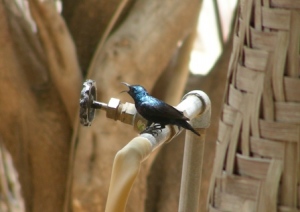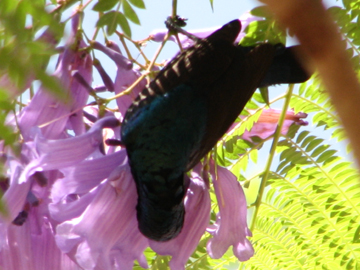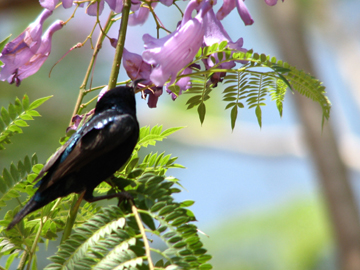Purple Sunbird.(Nectarina asiatica )
-RagooRao
It is summer down here in the south and most of the flowering trees are in full bloom. This is when one can see a good
flock of Purple sunbirds swarming to savour the nectar.
 A small bird typical of the size of all sunbirds with a slender long curved beak flitting from flowering tree to
tree with a glistening purple plumage, almost iridescent, with a few rust brown and yellow patch on the chest is the male Purple sunbird in breeding plumage. The females are a paler olive brown above and pale yellow under parts. The male in non-breeding season
looses much of his glistening colors and looks almost like the female except for a black stripe running down the chest.
A small bird typical of the size of all sunbirds with a slender long curved beak flitting from flowering tree to
tree with a glistening purple plumage, almost iridescent, with a few rust brown and yellow patch on the chest is the male Purple sunbird in breeding plumage. The females are a paler olive brown above and pale yellow under parts. The male in non-breeding season
looses much of his glistening colors and looks almost like the female except for a black stripe running down the chest.
Distribution is throughout the country. The best time to observe these birds in the best of their radiant colors is when
most of the forest trees bloom in summer months. Come summer and the trees burst with nectar filled flowers and the purple sunbird is a sure guest to feed on these nectar filled blooms. They literally arrive in flocks of 20 to 30 birds, the males claiming
territory and nectar rights on trees, chasing away the other male contenders. The females quietly hover around the birds, typical of all sunbirds, and go about their feeding spree.
Its is really a sight to see these birds hovering very close to the underside of the bell shaped flowers and sending
their long curved slender beaks into the flowers to draw nectar. Their wing beats are so rapid, the bird almost looks suspended in mid-air drawing nectar. These birds habit gardens with flowering trees, and shrubs. They are more easy in the deciduous forests
surrounding villages. They somehow avoid thickly populated urban areas unlike the Purple-rumped sunbird. 
The breeding male is a very proud bird, who keeps uttering the typical sunbird.cheewit....cheeevit...cheevit..raising
and lowering his wings constantly displaying brilliant yellow and scarlet tufts under his armpits.
Apart from nectar these birds also relish a lot of spiders and other small insects they find under the leaves. The brood
of chicks is brought up on insects and spider diet. March to may is the breeding season.
The nest is again typical of all sunbirds, a long pendulous pouch of soft dried grasses and held together by cob-webs.
Only the female builds the nest while the male is just being a scout looking for any intrusions and alerting her. They usually select a long slender bough, which will be swaying in the winds to build a nest. Perhaps this keeps egg stealers from venturing close
to the nest. Two or three greyish or greenish white eggs with blotches of various brown hues are laid. Only the female incubates. Once the chicks are hatched the male also steps in like a dutiful father and feeds the chicks along with the female. The female
keeps the nest tidy by removing all the droppings of the chicks from the nests. Perhaps this helps in preventing any fungus formation inside the nests.
A marvelous creation of nature, these birds are the main agents for fertilization of some trees. Their activity keeps
our forests going with new seeds forming to get dispersed and keep the ecology going.
